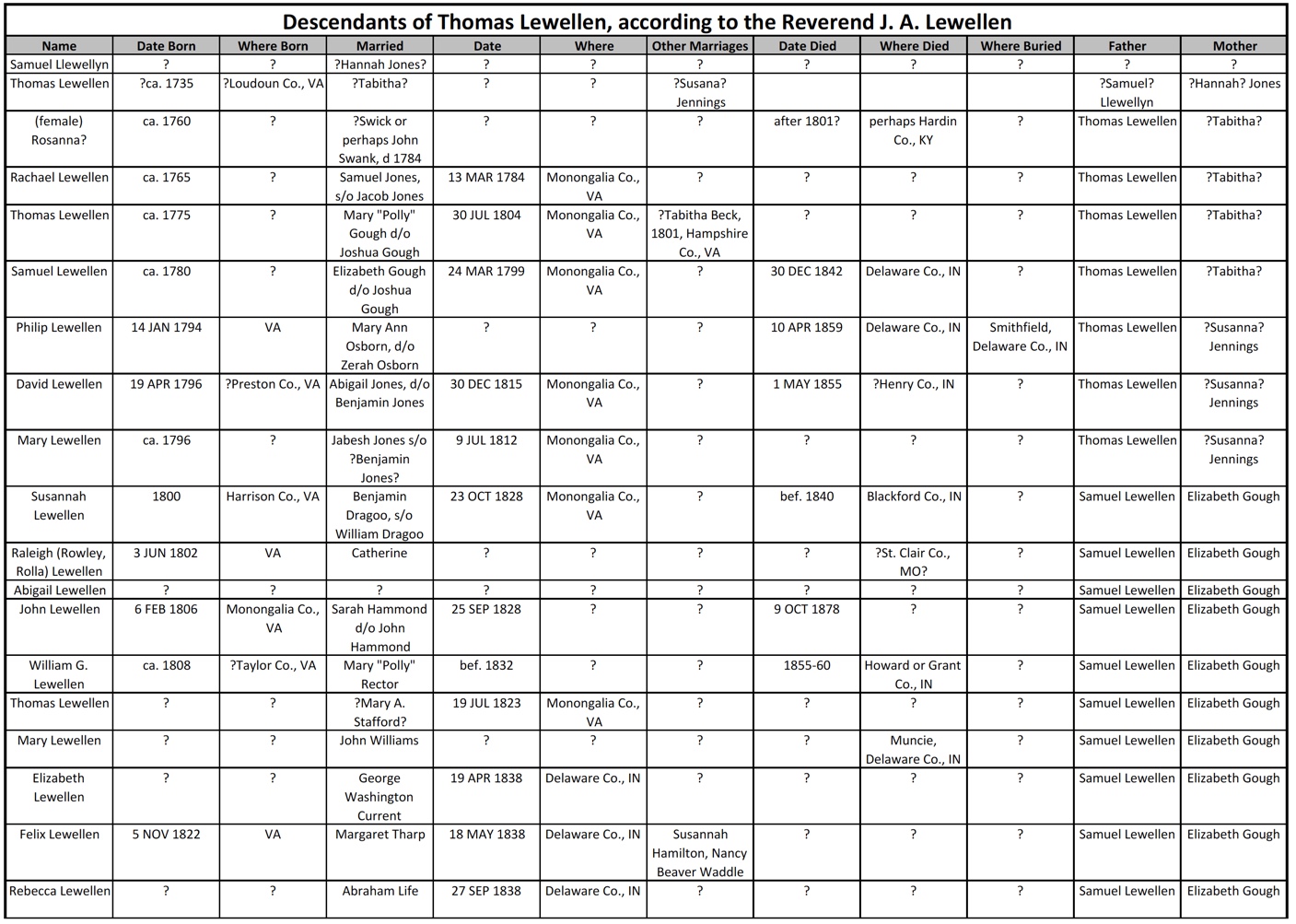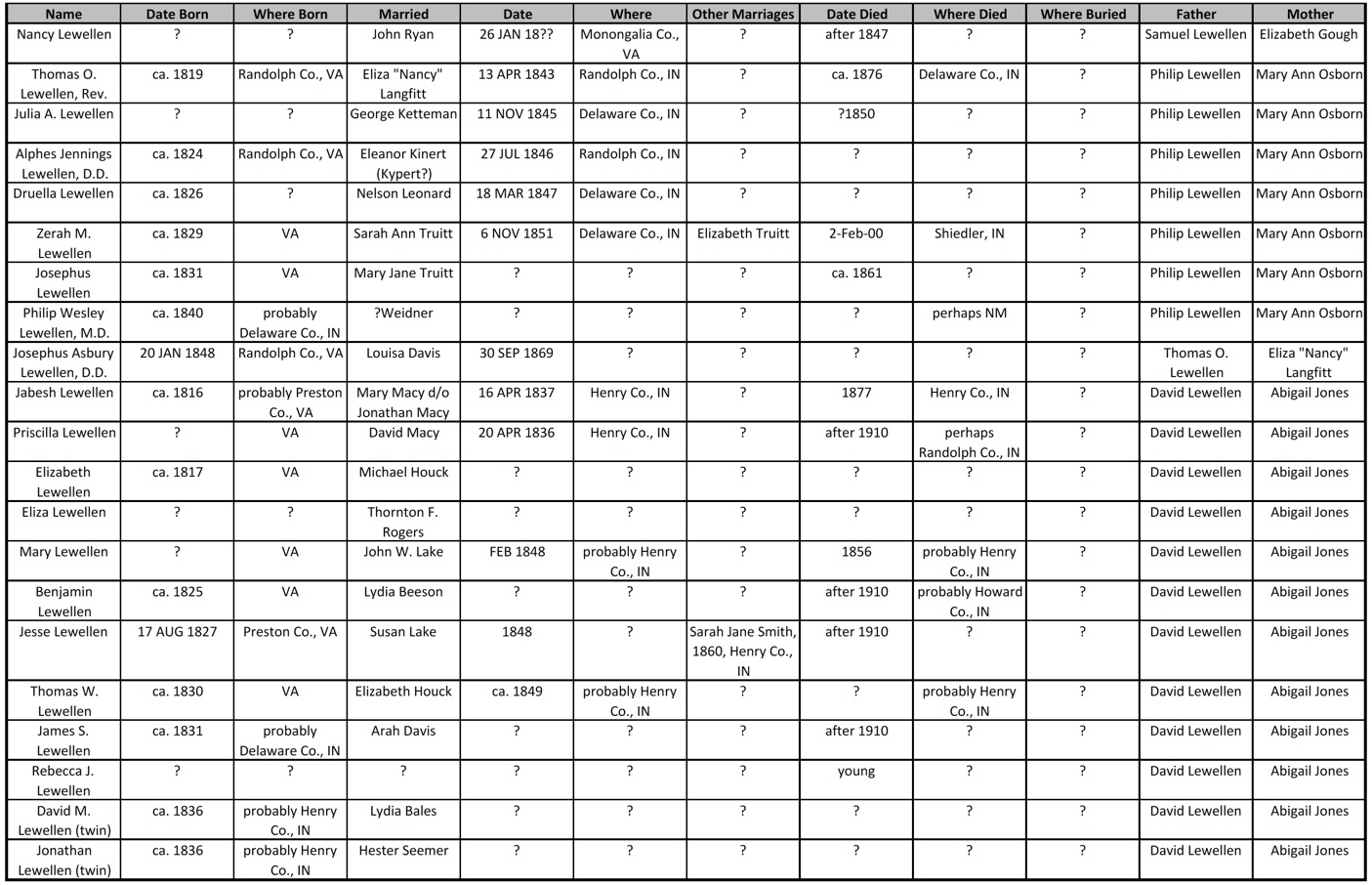Family Legends - Part 2
Tradition 2:
The three brothers
"Rev. Alpheus Jennings Lewellen, Farmland, Ind., Methodist, is the son of Philip Lewellen, and he was the son of Thomas Lewellen, who was the grandson of one of three brothers who came from Wales to America in a very early day...." [1]
In pursuit of tradition: 2
In this column in Llewellyn Traces, Vol. 1, No. 1, we discussed the booklet The Condensed History of the Lewellen Family in Wales and the United States published in 1910 by the Rev. J. A. Lewellen, D.D., Muncie, Indiana. The Reverend Josephus Asbury5 Lewellen, author of the booklet, was the nephew of Alpheus Jennings4 Lewellen, subject of the biographical sketch above, which is presented as
"Tradition 2."
Alpheus Jennings4 Lewellen, a Methodist minister (as was his nephew), was born in 1824 to Phillip3 and Mary Ann Osborn Lewellen, in Randolph County, Virginia, according to this bio graphical sketch. His grandfather was Thomas2 Lewellen and his grandmother the elusive unknown Jennings, from whom Alpheus inherited his second given name.
In the biography of Alpheus Jennings4 Lewellen, we have the second reference that Thomas2 Lewellen was the grandson of one of a trio of "original three brothers
... to America." According to the Reverend Josephus Asbury5 Lewellen in his booklet, Thomas2 Lewellen was a son of Samuel1 Llewellyn; therefore, according to this family tradition, Samuel was a son of one of the original immigrant brothers. (Please remember our disclaimer: it's not fact until it's been proved.)
In his booklet, the Reverend Josephus Asbury Lewellen identifies the patriarch of the family, as far back as his "research" had taken him, as the Samuel Llewellyn who married the "widow Jones, mother of Jacob Jones."
Undocumented sources give Samuel1 Llewellyn a wide range of birthdates. We will not add to the confusion, already widespread, by stating a supposed birthdate here. We hope that eventually some Bible records or another form of documentation will come to light to place Samuel in his proper location, with a birth date and birthplace - perhaps even with parents; find a marriage record or two; give his wife (wives?) full names; authenticate the names of his children; ascertain his death, and substantiate all the other things about him that are circulating at present as mere hearsay. If anyone has any proof of Samuel and his children, will you please share your records?
In discussions with those researching Samuel we have suggested gathering all the published information on Samuel to compare publication dates, and then take the earliest publication and try to track down the source of that information. We are sure that many published accounts of Samuel are merely copies of information gathered from other copies of information gathered from other copies of information, and soon.
Obviously, when the Reverend J. A. Lewellen briefly mentioned his great great grandfather Samuel in his booklet, nearly 100 years ago, he, too, knew of Samuel only by hearsay. The absence of documents linking Samuel with the variety of places he is reputed to have settled leaves us with a large void. It would seem that in a family that supposedly had at least eight sons, and several daughters, there would be some records surviving.
Little reliance can be placed upon published information about Samuel. We all realize information in Virkus can not be considered as reliable. We wonder if published material in various county histories is any more certain. The land records attributed to Samuel "Lewellen" in Monongalia County, Virginia, are not specific as to which Samuel or how many Samuels they pertain to. Some Monongalia land records, of somewhat later dates than those we believe were created by Samuel1, can definitely be attributed to another Samuel who in his will, probated in Louisville, Jefferson County, Kentucky, in 1822, mentions his tract of land in Monongalia County, Virginia.
We have no quarrel with the assumption that there was a Samuel, often referred to as "old" Samuel, who lived ca.1770 in Monongalia County, Virginia. In fact, there were several Samuels living in Monongalia County at the same time, each old enough to create records there. Our argument is with perpetuating unproved information by attributing "descendants" to "old" Samuel merely because it is convenient to do so.
For that matter, we have no proof that the family being dis cussed here actually descends from "old" Samuel. Just because the Reverend Josephus Asbury Lewellen wrote so in his booklet doesn't make it so. However, it is the roots of this Samuel1 that the Reverend Josephus Asbury Lewellen placed at the base of his family tree.[2] If the Reverend Mr. Lewellen was correct, then Samuel's father is somewhere in American records, too.
We are extremely grateful to have the Reverend Mr. Lewellen's booklet and so thankful he wrote what he did. It certainly gives us a place to start, even though he included few dates and even fewer place names, and as mentioned earlier, no references for any of his "facts." In some places, his writing is vague, making it difficult to interpret just what he was trying to say. In a couple of places he seems to repeat himself by offering different versions of the same material. The repetition of the
same given names from generation to generation and from family unit to family unit adds to the confusion. And his discussion of Thomas3 supposed son of Thomas2 is very confusing. Even so, his book is a treasure.
(please see footnote[3])
As we study the migration patterns and places of settlement of this one Lewellen family, we discover several interesting coincidences:
-
When this family arrived in Indiana ca.1830, it settled in the section of original Randolph County (Indiana) which (in 1827) was taken from Randolph to become Delaware County. In Randolph County, since 1813, was the family of Meshach Lawallin, son of Shadrach and Deborah Burson Lewelin, whom we first discovered in Loudoun County, Virginia, around 1757. And speaking of Loudoun County, remember our earlier mention of three Thomases in Loudoun County tax records.
-
Several of Thomas2's descendants migrated, about 1855, from Delaware County, Indiana, to live near the Lewellens who had arrived in Missouri from Ohio County, Kentucky, around 1818. The Ohio County Lewellens settled first in St. Charles County, Missouri, going later to Pike, Ralls, Monroe, and Clark counties (Missouri).
-
The Lawellins who settled in Randolph County, Indiana, in 1813, had migrated to Indiana, with a brief stay in Ohio, from Nelson and Hardin Counties, Kentucky. In Kentucky, Ohio County, from which the Pike County (Missouri) Lewellens had come, had been taken from Nelson and Hardin Counties. The Randolph County Lawallins and the Pike County Lewellens were all in Nelson, Hardin, and Ohio Counties, Kentucky, at about the same time.
-
Although the Lewellen individuals discussed in these first two traditions were settlers in Delaware County, Indiana, at least three other members of that family went to Henry County, Indiana, about the same time. Rachel3 Lewellen, who married Samuel Jones, son of Jacob Jones (sup posed son of Samuel1 Llewellyn's wife ,"widow Jones"); David3 Lewellen, who married Abigail Jones, a granddaughter of Jacob Jones; and Mary3 Lewellen, who married Jabish Jones, probably a grandson of Jacob Jones, all settled in Henry County, Indiana. Rachel Lewellen Jones was a daughter of Thomas2 Lewellen by his first marriage; David Lewellen and Mary Lewellen Jones were children of Thomas2 by his second marriage. And at the time, Henry County was also the location of at least one son of the William Lewelling, who died in Randolph County, North Carolina, 1798/99.
It gets curiouser and curiouser!
By using several biographical sketches, censuses, marriage records, wills, and land records, as well as the Reverend J. A. Lewellen's 1910 booklet about his family, we feel we have reconstructed this family fairly accurately, although incompletely. Please be aware that probably there are errors.
Source: Llewellyn Traces, Vol. 1, No. 2 June 1989
E. C. Tucker, History of Randolph Co., Indiana. Chicago, 1882, p.168. ↩︎
In his booklet, the Reverend Mr. Lewellen names the children of his great grandfather Thomas2 Lewellen and goes on to discuss marriages and children of that generation., as well as some for the following generation. (Censuses, marriage records, wills, biographical sketches, at least one family history, and correspondence have been helpful in sorting out the tangled narration in the Reverend Mr. Lewellen's booklet.) The only references The Reverend Mr. Lewellen gives for his writing are "Goodrich's History of All Nations" (for his introductory material about Wales) and "Esq. J. A. Jones, J. and S. Lewellyn, and others . . ." with no further identification (for his material dealing with his family line). How we wish he had further identified J. A. Jones and J. and S. Lewellyn, as well as all the "others!" ↩︎
I retyped the data from the original and I tried to stay true to their spellings and their mistakes. There was one row of the original image that made no sense and I omitted it (it had names in date fields and two names in the name field so I could not decipher what was intended). ↩︎

